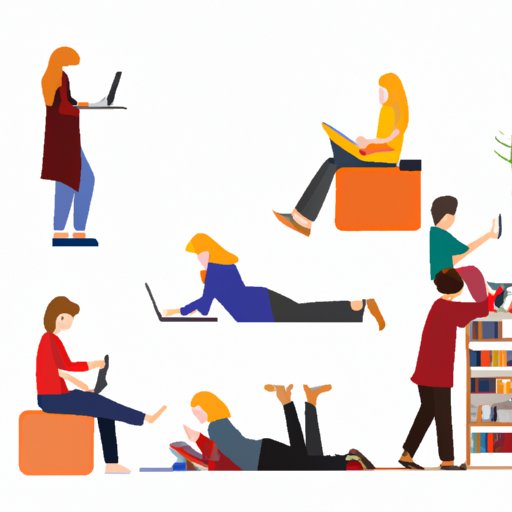Introduction
The rise of technology in recent years has revolutionized the way students learn and interact with each other. From online textbooks to AI-based tutoring applications, technology has become an integral part of the modern student experience. In this article, we will explore how technology helps students succeed in their academic pursuits and provides them with a range of tools to make their learning experience more efficient and enjoyable.

Increased Access to Educational Resources
One of the most significant benefits of technology for students is increased access to educational resources. In today’s digital age, students can easily access a wide range of learning materials from the comfort of their homes.
Online Textbooks and Courses
Gone are the days of lugging around heavy textbooks. With online textbooks and courses, students can access course material from any device with internet access. Many universities now offer online versions of their textbooks, which can be accessed anytime, anywhere. Additionally, many educational institutions provide students with access to online courses that allow them to learn at their own pace and from the convenience of their own home.
Digital Libraries and Databases
In addition to textbooks, students can also access a wealth of information through digital libraries and databases. These online resources provide students with access to a vast collection of books, articles, and other documents that can help them with their studies. Additionally, many libraries provide students with access to specialized software, such as citation managers and statistical analysis tools, which can be invaluable for completing research projects.

Improved Communication with Teachers and Peers
Technology has also improved the way students communicate with their teachers and peers. Social media platforms, video conferencing, and online discussion boards have made it easier than ever for students to connect with their instructors and classmates.
Social Media Platforms
Social media platforms, such as Facebook and Twitter, have made it easier for students to keep in touch with their teachers and peers. Instructors can use these platforms to post announcements and updates, while students can use them to ask questions and collaborate on projects. Additionally, many universities now have their own social media sites, which provide students with a convenient way to stay informed about campus events and activities.
Video Conferencing
Video conferencing has also become an important tool for improving communication between students and instructors. Services like Skype and Zoom allow students to virtually attend lectures and office hours, as well as participate in group discussions with their peers. Video conferencing also provides students with a convenient way to get feedback from their instructors and receive assistance with their assignments.
Online Discussion Boards
Online discussion boards are another great way for students to communicate with their peers. These forums provide students with a platform to discuss topics related to their classes and share ideas with one another. Additionally, many universities now have dedicated discussion boards for each class, which can be a great way for students to get help with their assignments and stay up-to-date on class discussions.
Facilitated Collaboration on Assignments
Collaborating with peers on assignments has been made much easier thanks to technology. Online tools, such as cloud storage and shared document editors, have made it easier for students to work together on projects without having to be in the same physical location.
Cloud Storage
Cloud storage services, such as Dropbox and Google Drive, provide students with a convenient way to store and share files with their peers. Students can use these services to securely upload and download documents, ensuring that everyone has access to the most up-to-date version of a project. Additionally, many cloud storage services offer collaboration features, allowing multiple users to work on a project simultaneously.
Shared Document Editors
Shared document editors, such as Google Docs and Microsoft Word, provide students with a collaborative workspace for completing assignments. These tools allow multiple users to work on the same document at the same time, making it easier for teams to collaborate on projects. Additionally, many shared document editors offer real-time chat features, allowing students to discuss their work as they go.
Enhanced Research Capabilities
Thanks to technology, students now have access to a wealth of information at their fingertips. Web browsers and search engines provide students with an easy way to access information on virtually any topic, making research much simpler and faster.
Web Browsers
Web browsers, such as Chrome and Firefox, provide students with a convenient way to access online resources. With a web browser, students can quickly and easily find information on any topic, from scholarly articles to news sources. Additionally, most web browsers offer built-in tools for organizing and managing bookmarks, making it easier for students to keep track of their research.
Search Engines
Search engines, such as Google and Bing, make it even easier for students to find the information they need. These tools allow students to quickly locate relevant information on virtually any subject, saving them valuable time and effort. Additionally, many search engines offer advanced features, such as filtering and sorting options, which can help students narrow down their results and find exactly what they’re looking for.
Streamlined Note-Taking and Organization
Technology has also made it easier for students to take notes and organize their work. Note-taking apps and online calendars provide students with helpful tools for keeping track of their assignments and staying organized.
Note-Taking Apps
Note-taking apps, such as Evernote and OneNote, provide students with a convenient way to take notes and store information. These apps allow students to quickly jot down ideas and capture essential details, making it easier for them to remember key points during lectures or discussions. Additionally, many note-taking apps offer features such as audio recording, which can be useful for capturing lectures or lengthy conversations.
Online Calendars
Online calendars are also invaluable tools for helping students stay organized. With an online calendar, students can easily create reminders for upcoming assignments and tests, ensuring that they never miss a deadline. Additionally, many online calendars offer additional features, such as task lists and goal setting tools, which can be helpful for staying on track with their studies.
More Efficient Studying and Test Prep
Technology has also made studying and test preparation much more efficient. Learning management systems and flashcard apps provide students with helpful tools for mastering course material and preparing for exams.
Learning Management Systems
Learning management systems, such as Blackboard and Canvas, provide students with a centralized hub for accessing course materials, submitting assignments, and tracking their progress. These systems also allow instructors to easily organize course content and provide students with timely feedback on their work. Additionally, many learning management systems offer interactive features, such as quizzes and discussion boards, which can be useful for reinforcing course material and preparing for tests.
Flashcard Apps
Flashcard apps, such as Quizlet and Anki, provide students with an effective way to study and memorize course material. These apps allow students to create digital flashcards with definitions, images, and other content, which can be used to quiz themselves and master challenging concepts. Additionally, many flashcard apps offer game-like features, such as leaderboards and progress tracking, which can make studying more enjoyable and engaging.
Personalized Learning Experiences
Finally, technology has enabled students to personalize their learning experiences. Adaptive learning software and AI-based tutoring applications provide students with tools for customizing their studies and getting the most out of their education.
Adaptive Learning Software
Adaptive learning software, such as Khan Academy and ALEKS, allows students to tailor their learning experience to their individual needs. These tools use algorithms to assess a student’s strengths and weaknesses and provide targeted instruction to help them master course material. Additionally, many adaptive learning programs offer personalized practice activities and feedback, which can be invaluable for improving a student’s understanding of a subject.
AI Tutoring Applications
AI tutoring applications, such as Socratic and Photomath, provide students with personalized assistance with their studies. These apps use artificial intelligence to analyze a student’s questions and provide step-by-step explanations, making it easier for them to understand difficult concepts. Additionally, many AI tutoring applications offer interactive features, such as video lessons and live chat, which can be extremely helpful for students who need extra help.
Conclusion
In conclusion, technology has become an invaluable tool for students, providing them with a range of tools to help them succeed in their academic pursuits. From increased access to educational resources to personalized learning experiences, technology has opened up a world of possibilities for students. By utilizing technology, students can get the most out of their education and set themselves up for long-term success.
Summary of Benefits
To summarize, technology provides students with a number of benefits, including increased access to educational resources, improved communication with teachers and peers, facilitated collaboration on assignments, enhanced research capabilities, streamlined note-taking and organization, more efficient studying and test prep, and personalized learning experiences.
Final Thoughts
Technology has become an indispensable part of the modern student experience. By taking advantage of the various tools available, students can greatly improve their academic performance and gain valuable skills that will serve them well in life.
(Note: Is this article not meeting your expectations? Do you have knowledge or insights to share? Unlock new opportunities and expand your reach by joining our authors team. Click Registration to join us and share your expertise with our readers.)
